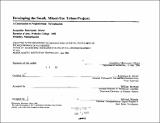| dc.contributor.advisor | Lawrence S. Bacow. | en_US |
| dc.contributor.author | Olivier, Jacqueline Morrissette | en_US |
| dc.contributor.other | Massachusetts Institute of Technology. Dept. of Architecture. | en_US |
| dc.date.accessioned | 2013-01-23T20:20:25Z | |
| dc.date.available | 2013-01-23T20:20:25Z | |
| dc.date.copyright | 1988 | en_US |
| dc.date.issued | 1988 | en_US |
| dc.identifier.uri | http://hdl.handle.net/1721.1/76547 | |
| dc.description | Thesis (M. Arch.)--Massachusetts Institute of Technology, Dept. of Architecture; and, (M.S. in Real Estate Development)--Massachusetts Institute of Technology, Dept. of Architecture, 1988. | en_US |
| dc.description | Includes bibliographical references (p. 87-88). | en_US |
| dc.description.abstract | Through out many cities in America, urban neighborhoods are characterized by the diminished vitality and extensive deterioration of their overall landscape. The consequences of modem city planning, architectural design and real estate development through out the past thirty years have abrogated much of the cohesive and diverse pattern of the historic urban fabric. Today, many urban areas suffer from the endless repetition of single use structures. Others suffer from the devastating neglect of little or no investment activity at all. The intention of this thesis is to investigate the development feasibility of the small, mixed-use project. Mixed-use is a building prototype combining various uses in one structure and is typified in the appealing character of many older American and European cities. The assertion made is quite simple; if it worked then why can't it work now? The particular focus of the inquiry concentrates on poor urban neighborhoods though the prototype is relevant in other urban areas. Requisite to the formulation of the project is the aim to responsibly support and stimulate community revitalization. It is concluded that the feasibility for small mixed-use development exists though many problems remain. Design on small sites as small as one half acre is difficult but possible. Such locations are suitable particularly where they sit at major intersections between residential and commercial districts. Economically the prototype remains weak; the development risks are great. Substantial investigation to identify the most beneficial instruments for obtaining equity, reducing development costs and increasing the revenues is required for projects of this kind. Nevertheless, the small mixed-use holds an important role in the future development of the urban landscape. The prototype promises to offer a considerable contribution to the increased health and revitalization of many urban communities. | en_US |
| dc.description.statementofresponsibility | Jacqueline Morrissette Olivier. | en_US |
| dc.format.extent | 88 p. | en_US |
| dc.language.iso | eng | en_US |
| dc.publisher | Massachusetts Institute of Technology | en_US |
| dc.rights | M.I.T. theses are protected by
copyright. They may be viewed from this source for any purpose, but
reproduction or distribution in any format is prohibited without written
permission. See provided URL for inquiries about permission. | en_US |
| dc.rights.uri | http://dspace.mit.edu/handle/1721.1/7582 | en_US |
| dc.subject | Architecture. | en_US |
| dc.title | Developing the small, mixed-use urban project : contribution to neighborhood revitalization | en_US |
| dc.title.alternative | Mixed-use urban project, Developing the small | en_US |
| dc.type | Thesis | en_US |
| dc.description.degree | M.S.in Real Estate Development | en_US |
| dc.description.degree | M.Arch. | en_US |
| dc.contributor.department | Massachusetts Institute of Technology. Department of Architecture | |
| dc.identifier.oclc | 18811867 | en_US |
